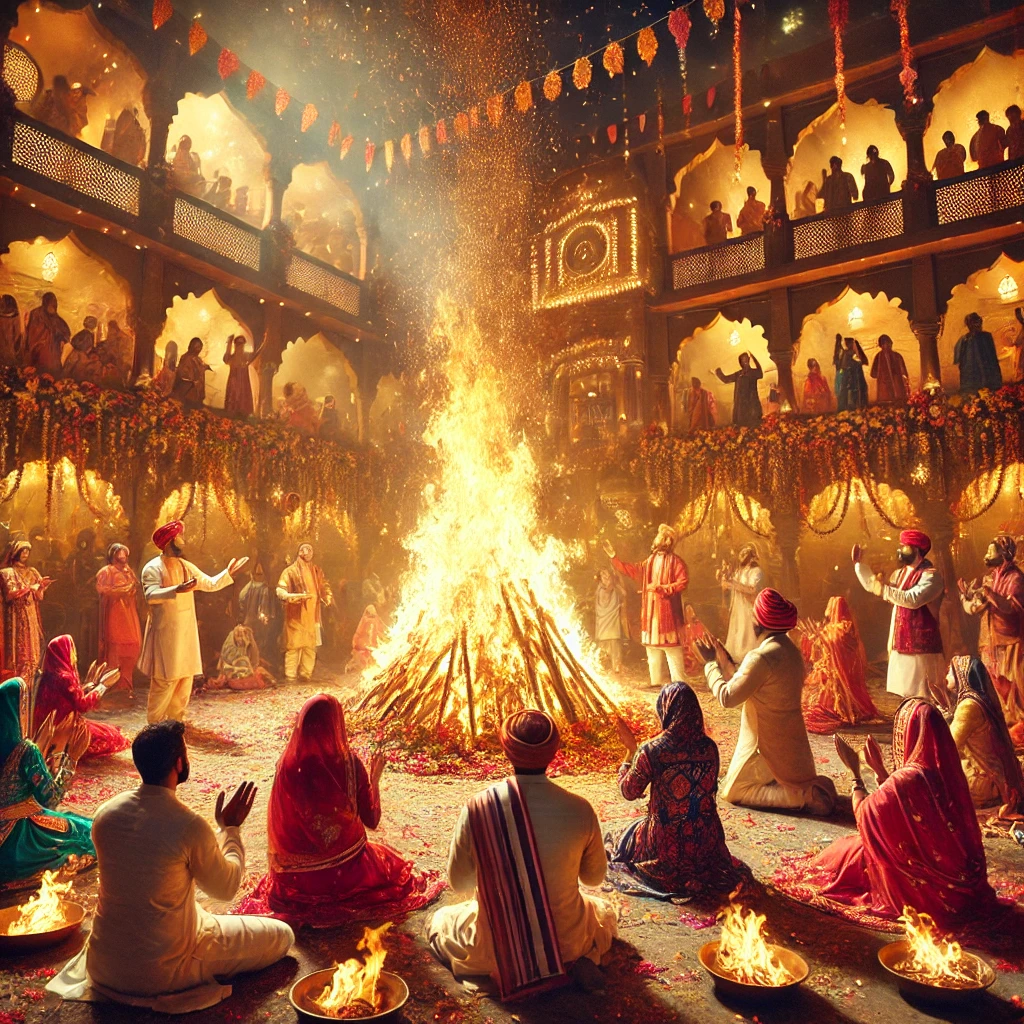Holi Ka Dahan: A Celebration of Good Over Evil

Discover the significance of Holi Ka Dahan, a vibrant festival symbolizing the victory of good over evil. Join us in celebrating this colorful tradition!
Saturday, 8 February 2025
Trending News Fox, Digital Desk Team, Kolkata
Edited by Saibal Bose
Holi Ka Dahan: A Celebration of Good Over Evil
Holi, the festival of colors, is one of the most vibrant and joyful celebrations in India. Before the exuberant festivities of playing with colors start, an important ritual takes place. This ritual is known as Holi Ka Dahan and holds deep cultural and religious significance. This ceremony symbolizes the victory of good over evil and is observed with reverence across various regions of India.
The Legend Behind Holi Ka Dahan
The tradition of Holi Ka Dahan is rooted in Hindu mythology, particularly in the story of Prahlad and Holika. According to legend, Prahlad was a devout follower of Lord Vishnu. His father, King Hiranyakashipu, was a tyrant who considered himself a god. He demanded that everyone worship him. Enraged by his son’s devotion to Vishnu, Hiranyakashipu plotted to kill him. He sought the help of his sister, Holika, who possessed a boon that made her immune to fire. Holika tricked Prahlad into sitting on a pyre with her. Still, divine intervention saved him. The flames consumed her while Prahlad remained unharmed. This event symbolizes the triumph of righteousness and faith over arrogance and evil.
The Ritual of Holi Ka Dahan
Holi Ka Dahan occurs on the evening before Holi. It typically happens on the full moon night (Purnima) of the Hindu month of Phalguna. The ritual involves the lighting of a bonfire, which signifies the burning of Holika. People gather around the fire, offer prayers, and carry out religious rituals to seek blessings for prosperity and happiness.
Key elements of the ritual include:
- Gathering of Wood and Materials: Days before the festival, people collect wood, dry leaves, and twigs. They also gather cow dung cakes to prepare for the bonfire.
- Setting Up the Pyre: A structure is built, often with an effigy of Holika placed on top.
- Lighting the Fire: The bonfire is ignited after sunset, with devotees chanting prayers and hymns, symbolizing the eradication of negativity.
- Circumambulation and Offerings: People walk around the fire (parikrama). They offer grains, coconut, and other sacred items as part of the ritual.
Cultural and Social Significance
Holi Ka Dahan is not just a religious observance but also a social event that strengthens community bonds. Families and neighbors come together, share sweets, and express goodwill. It serves as a reminder to let go of past grievances and embrace positivity.
Modern-Day Celebrations
While the core essence of Holi Ka Dahan remains unchanged, its celebration varies across different regions. In some areas, the ritual is accompanied by folk songs and dances, making it a lively affair. In other areas, unique customs add a local flavor to the event. People burn effigies of evil figures or carry out traditional plays.
FAQ for Holika Dahan
1. What is Holika Dahan?
Holika Dahan, also known as Chhoti Holi, is a Hindu festival celebrated on the eve of Holi. It signifies the victory of good over evil. The festival involves lighting a bonfire to symbolize the burning of Holika. She was a demoness who tried to harm Prahlad, a devotee of Lord Vishnu.
2. When is Holika Dahan in 2025?
Holika Dahan in 2025 will be observed on Sunday, March 16. The best time for the Holika Dahan ritual is known as Muhurat. It varies based on local Panchang calculations. This ritual should be performed in the evening during Pradosh Kaal.
3. What is the significance of Holika Dahan?
Holika Dahan symbolizes the triumph of righteousness over evil. It is based on the legend of Prahlad and Holika. In this legend, Lord Vishnu saved his devotee Prahlad from his evil aunt Holika. Holika was immune to fire but got burned due to divine intervention.
4. How is Holika Dahan celebrated?
- Setting up the bonfire: People gather wood and combustible materials to build a pyre.
- Puja & rituals: The pyre is worshiped before being set on fire. Offerings include coconut, wheat, and gram seeds.
- Burning of Holika: The bonfire is lit, symbolizing the destruction of evil forces.
- Celebrations: People sing, dance, and prepare for the Holi festival the next day.
5. What are the traditional rituals of Holika Dahan?
- Placing an effigy of Holika on the bonfire
- Applying tilak (vermilion) and offering prayers
- Walking around the fire (Parikrama) and throwing offerings
- Seeking blessings for health, happiness, and protection from evil
6. Where is Holika Dahan celebrated?
Holika Dahan is widely celebrated across India and Nepal. It is especially popular in North Indian states like Uttar Pradesh, Rajasthan, Bihar, Madhya Pradesh, and Punjab. It is an integral part of Holi celebrations.
7. What should be avoided on Holika Dahan?
- Avoid using non-environment-friendly materials in the bonfire.
- Do not disrespect the rituals or make fun of religious sentiments.
- Make sure safety while lighting the bonfire.
8. What is the connection between Holika Dahan and Holi?
Holika Dahan is performed on the full moon night (Purnima) of the Phalguna month, marking the beginning of Holi celebrations. The next day, people celebrate Holi by playing with colors, symbolizing joy and togetherness.
9. What is the story behind Holika Dahan?
According to Hindu mythology, Hiranyakashipu was a demon king. He wanted to kill his son Prahlad because Prahlad was a devotee of Lord Vishnu. His sister Holika, who had a boon making her immune to fire, sat with Prahlad in a burning pyre. Nevertheless, due to divine protection, Holika was burned, and Prahlad was unharmed. This event is commemorated through Holika Dahan.
10. What offerings are made during Holika Dahan?
People offer coconut, wheat, barley, mustard seeds, sugarcane, and wood into the fire. These symbolize prosperity and the burning away of negativity.
Would you like more details on specific rituals or local traditions of Holika Dahan? 😊🔥
Conclusion
Holi Ka Dahan is a significant prelude to the joyous festival of Holi. It reinforces the timeless message that truth and virtue always prevail over evil. The flames of the bonfire rise. They illuminate the path of righteousness. They urge people to lead lives filled with kindness, faith, and harmony.
Here are some relevant tags for Holika Dahan:
General Holika Dahan Tags:
#HolikaDahan #ChhotiHoli #HolikaDahan2025 #VictoryOfGoodOverEvil #HoliFestival
Religious & Mythological Tags:
#HolikaPooja #PrahladStory #Hiranyakashipu #Bhakti #HinduFestival
Celebration & Rituals Tags:
#HolikaBonfire #HolikaDahanRituals #FestivalOfFire #HolikaPuja #TraditionalHoli
Regional & Cultural Tags:
#IndianFestivals #HoliInIndia #HoliCelebrations #DesiFestivals #HinduTraditions
Social Media & Engagement Tags:
#HoliVibes #FestiveMood #Spirituality #IndianCulture #FestivalsOfIndia
Would you like any location-specific or trending hashtags? 😊🔥
Discover more from Trending News Fox
Subscribe to get the latest posts sent to your email.




